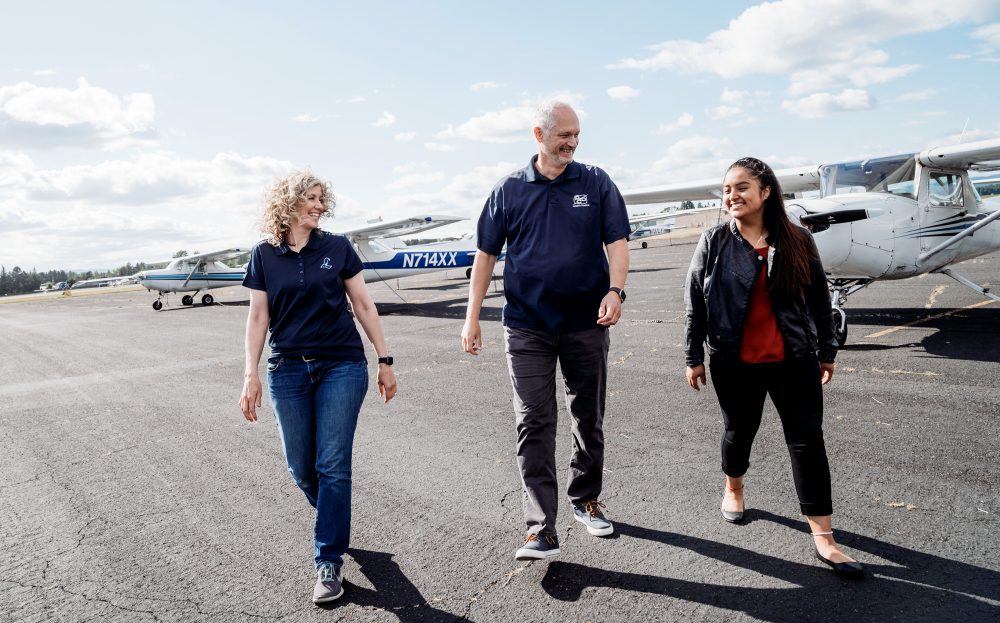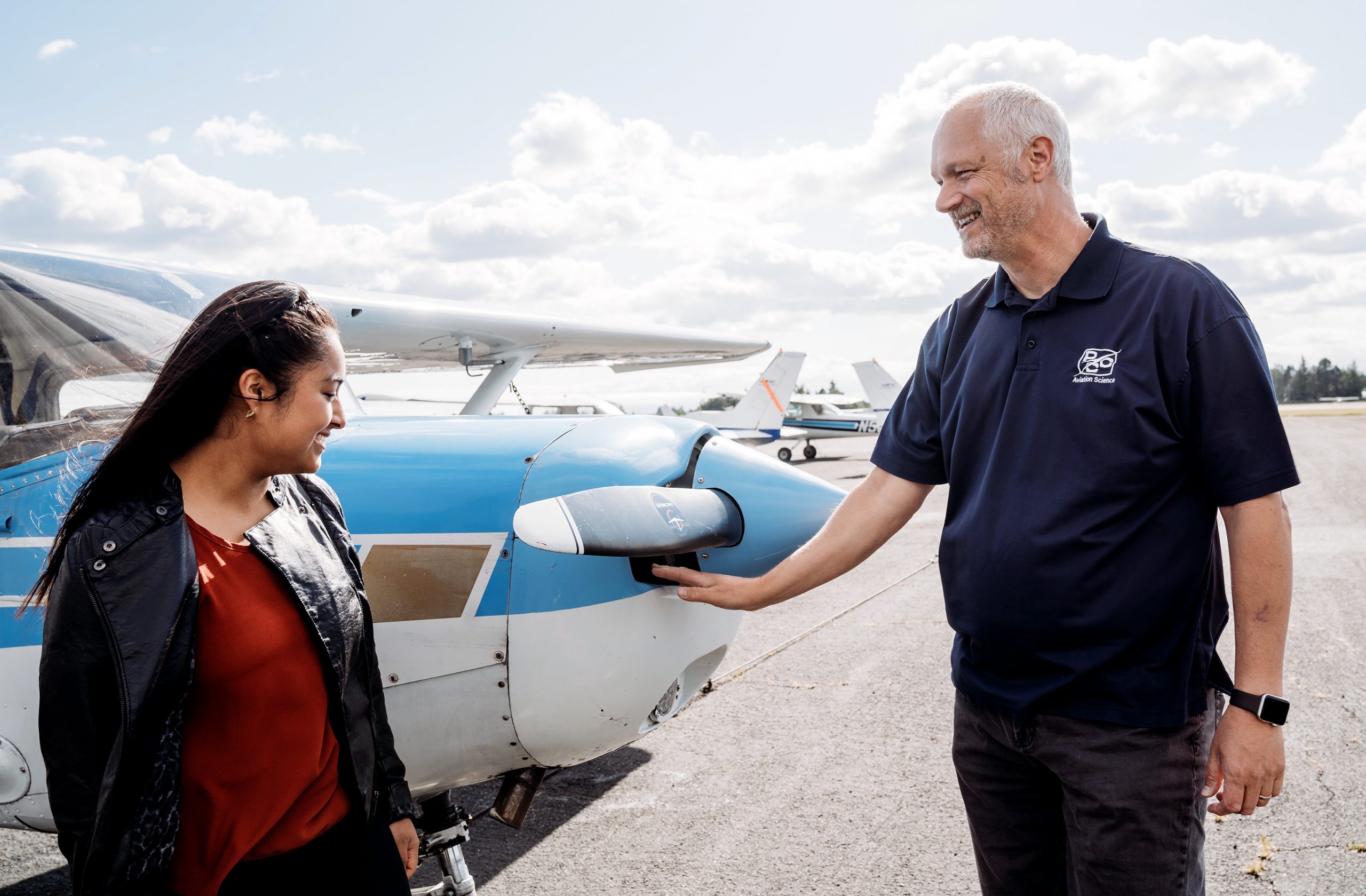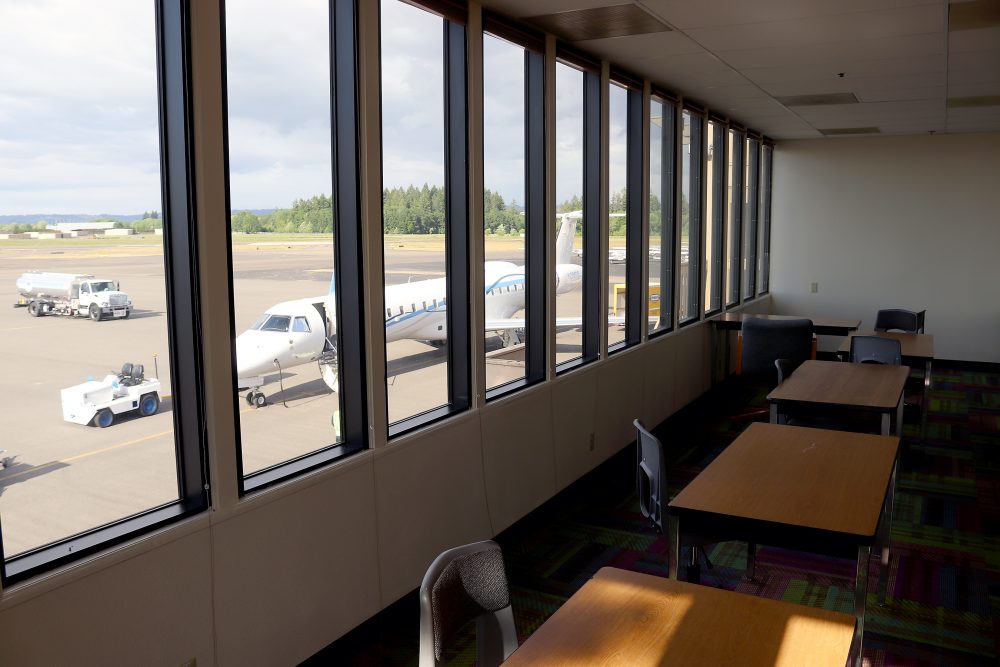This content was published: June 21, 2021. Phone numbers, email addresses, and other information may have changed.
Aviation programs create new Hillsboro education pathway curriculum for high schoolers
Story by James Hill.

Left to right, flight teacher Sheri Fisher, PCC Aviation Science Chair Larry Altree and O-ACE student Ivette Alonso Garcia.
A new education pathway is giving under-represented high school students in Hillsboro a chance at flying high in the field of aviation.
Portland Community College has partnered with the Hillsboro School District on its new Oregon Aerospace Careers for Everyone (O-ACE) Program. This is a training pathway program for high school students interested in careers as aviation maintenance technicians, avionics technicians, or professional pilots. A big goal of the program is to diversify the aviation industry by introducing more nontraditional and under-represented candidates, like women and people of color, to the field.
PCC’s Aviation Science and Aviation Maintenance Technology faculty helped design the curriculum for the classes to match courses offered in their programs. Students in the pathway can earn dual college credits through PCC and can participate in a non-profit “Flight Club,” created and operated by PCC students. This club allows students access to aviation activities after school.

Dual Credit at PCC
Like the Oregon Aerospace Careers for Everyone Program, the Dual Credit Program offers local high school students the opportunity to earn college credit. These classes are regular PCC courses, but taught at a high school by an approved high school teacher.
According to a report by Boeing, in the next 20 years the aviation industry will face an immense shortage of skilled workers to maintain the North American fleet with pilot demand totaling approximately 208,000, technicians at 192,000 and cabin crew at about 169,000. By unlocking the doors to aviation careers to historically under-represtented students, the better chance the industry has at filling this demand.
Chris Barber, a Southwest Airlines pilot and an Oregon Airshow Charitable Foundation board member, initially approached PCC about creating a program that could spur interest in aviation for high school students. It is estimated that 93% of the industry’s professional pilots are made up of white males.
“As an airline pilot I recognize that our community looks very similar to myself,” said Barber, who is white. “We do not do a very good job of recruiting females or people of color to the aviation community. We need to diversify because there’s a huge shortfall.”
As a result, PCC, the Hillsboro School District, the Oregon Air Show Charitable Foundation Board and the Port of Portland all came together to make the educational pathway happen. The Port of Portland provided classroom space at the airport’s terminal building in the form of the former KUIK radio station studios, which has expansive views of the airport’s tarmac. The Oregon Air Show Charitable Foundation funded the renovation along with donations of services from local businesses.
The renovation and remodel was led by experienced volunteers from the Hillsboro Rotary Club, Hillsboro School District, Oregon International Air Show, Port of Portland and the Oregon Air Show Charitable Foundation. In total, the partners tallied 1,800 to 2,000 volunteer hours to make this project happen.
“Breaking down barriers and providing equitable, educational opportunities is critical to our roadmap for regional prosperity,” said Steve Nakana, social equity manager for the Port of Portland.
Students from any Hillsboro high school are eligible to apply for the O-ACE Program with courses built into the students’ daily schedule. They can start taking aviation immersion courses and summer boot camps in addition to college-level credit classes. By the time they graduate, they will have amassed 16 dual credits for Aviation Science or up to 13 credits for Aviation Maintenance through PCC and can seamlessly transition into either program.
The first-ever cohort started this year and has nearly 40 students from around the school district enrolled.
“Many students within the district will never get the opportunity to experience aviation mainly because of the cost,” said Sheryl Fisher, a bilingual licensed pilot who teaches the classes. “This program gives students more career choices in their lives.”

When in-person courses resume, the refurbished classroom at the Hillsboro Airport will be a hub of learning.


Career Technical Education (CTE) provides life-long skills to students, a chance to explore careers, build academic and career skills, provides hands-on project based learning opportunities, allows students to apply what they learn in the classroom, and provides those “aha” moments when the practical makes a connection with the theoretical. Go CTE!
Awesome
Excellent effort to “straighten up the aviation industry”. The conventional path has been very costly and debt ridden for students, so if there is a way to help with costs – that would no doubt be a plus.
Toby Dittrich CFI, CFII, MEI
This will certainly pay off to the participants as it involves a young persons thinking by processing info and actions in ordered operations, and has direct links to career options as the industry is VAST… and hiring most importantly.